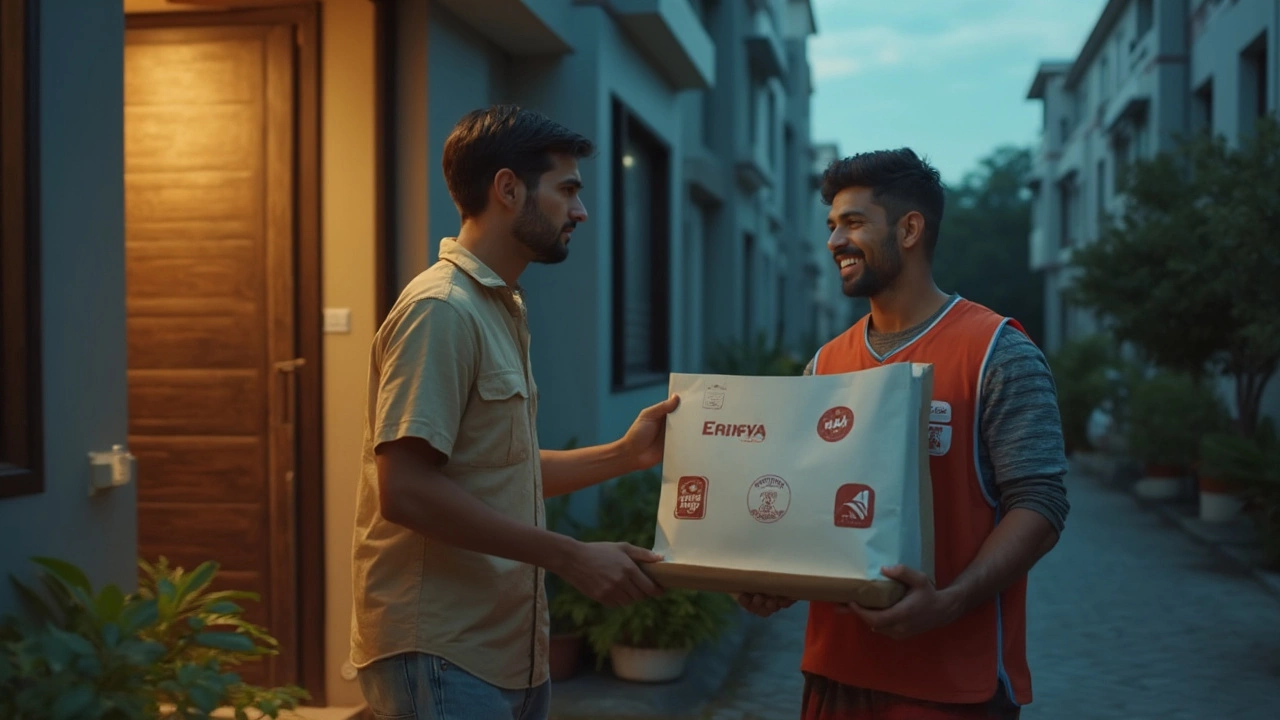It's wild how you can be out walking your kid, scrolling through your phone, and suddenly see that local courier companies are popping up left and right. Uber Eats drivers, Amazon folks hustling at every apartment—this city almost runs on delivery. But what if you want in? Banks aren't lining up to drop cash into your account. Got no start-up fund, no shiny van, not even a fancy app idea. Still, you want to break in and carve out a piece for yourself, maybe partly for the cash, partly because it gives you more flexibility than the nine-to-five does. Here's a closer look at how you can pull this off—even if your wallet is flatter than a pancake on Dundas.
Understanding the Landscape of Zero-Capital Delivery Startups
Toronto has become a testing ground for every delivery solution you can imagine. Back in the pre-pandemic days, delivery companies were local mainstays and only the big shipments happened regularly. Fast forward to today, grocery runs, small packages—it’s all coming to your door. According to a 2024 Statista report, the global gig delivery market hit an insane $250 billion in value, and it’s only projected to grow. But those big numbers hide something: most new delivery businesses aren’t backed by investors or huge bank loans. Many are one-person shows, running deliveries off an old sedan or bike. The barrier to entry sits lower than ever. You don’t need a DHL-sized warehouse. You don’t even need your own vehicle if you’re smart about it.
It’s not just about moving stuff from point A to B. It’s about responding to the things people forget, lose, or just don’t want to go get. You don’t need special qualifications—many delivery newbies in 2023-2025 started just by signing up for an app, joining Facebook groups, or reaching out to neighbors. Toronto’s intense neighborhood network makes this even easier. Immigrants and students, especially, are killing it in this space. The city’s transit, coupled with apps like Nextdoor or even Reddit’s r/Toronto, means there’s no shortage of hustle-friendly zones. The demand is there for everyday deliveries—especially those that bigger companies overlook, like late-night snacks or replacing lost keys at 11 PM.
If you’re still wondering about competition, here’s the thing: Nobody expects you to take on Amazon. People are looking for fast and friendly, not mega-corporate. Use local Facebook groups or even Kijiji to see what people around you need, and you’ll notice a pattern. The big lesson? The money isn’t in high-tech; it’s in being reliable and super local.
Finding Your Niche and Using Free Tools
Landing clients without a single dollar? Sounds fake, but it’s seriously doable. The trick is picking a niche. Maybe you're the guy who delivers forgotten lunchboxes to school, or you specialize in short-range runs for elders who don’t want to deal with traffic. If you can find the group that values quick, neighborly help over ultra-slick tech, you’ve got something. School WhatsApp chat? Bingo. Dog-owners’ Facebook page? Jackpot.
You don't need to build an app from scratch either. There are free tools out there that can get you started—no coding degree required. Google Maps for routes. WhatsApp for updates. Canva for making simple flyers. Set up a free Gmail account with your business name and a Google Sheet for your first orders.
Boost your exposure by making posts where people are actually looking for quick solutions. Facebook Marketplace lets you list your service for free. Instagram Reels are mostly free and can reach thousands if you tag local hashtags (think #TorontoDelivery or something specific to your neighborhood). Prefer old school? Print out flyers at the library and pin them at coffee shops—Toronto’s indie cafes are surprisingly chill about these.
Want to reach more folks? Offer a few first deliveries for free or “pay what you can.” Those early customers will talk. Encourage reviews and post screenshots with permission. Even two or three happy clients create a snowball effect if you’re friendly and fast. Every time I brought my son, Everett, along on a delivery, the customer got a kick out of the ‘family business’ feel, even if we were just amateurs. Be human; it pays off.

Using What You Have: Vehicles, Bikes, or Just Your Feet
You had to have a van to break into the delivery space—that’s what everyone thought just a few years ago. But now, electric scooters whiz past gridlocked cars, and bikes beat Ubers in the city core every Friday. The key is to embrace the mode of transport you already have. If you own a car, great—it’ll expand your range. But if you don’t, don’t sweat it. City biking is crazy efficient and less prone to traffic. Walking deliveries? Still a thing, especially in dense neighborhoods like the Annex or Little Italy, where parking is a nightmare anyway.
Don’t have a bike? Community bike shares like Bike Share Toronto are a $7 starting investment for a day of deliveries—less than a fancy coffee run would cost. Keep your deliveries hyper-local, and you’ll make up that cost before closing time. For people under 29, UBER offers Jump e-bikes for rent, too.
If you use your own vehicle, don’t feel pressured to take on every job. Stick to lighter packages at first. The last thing you want is to blow your first week’s profits on a traffic ticket or car trouble. Local folks often care less about speed and more about reliability—show up when you say you will, and word gets around. If you own a smartphone (almost everyone does), download free mileage tracker apps like MileIQ or Stride. These let you track your routes for free and start prepping for those business deductions. The CRA allows for mileage write-offs in Canada, so hang onto your records, even in the early days.
If your knees are up for it, offer specialty bike delivery for fragile items—flowers, birthday balloons, or anything that can’t be bounced around. Your ability to care for weird loads can give you an edge over big app-based services. When a friend of mine started out, he delivered cupcakes door-to-door by foot, promoting herself directly to the building’s residents. Three months in, she’d cleared $1,500 just in repeat orders. You’d be surprised how specific you can get and still turn a profit.
Getting Paid Without Upfront Risk
People get nervous about handing over their money to a new delivery guy with no “proof of business.” There’s a smart way around this. Use e-transfer, PayPal, or even cash at the door for the first few clients if they’re reluctant. For security—yours and theirs—keep receipts. Free apps like Wave let you send basic invoices. Maintain a simple spreadsheet to track everything. It’ll give you peace of mind and make filing taxes less of a mad scramble next April.
Pricing can trip up new businesses. Check what the big-name players charge, then see where you fit. If DoorDash wants $6 for a local run, maybe you offer the same for $5 or add a personal touch. Get creative: bundle errands (“I’ll pick up dry cleaning with your package, $2 extra”). Run a “friends and neighbors” promo—first order at a discount, then regular price.
If you know any local businesses, see if they need help with daily drop-offs. Local flower shops and bakeries often don’t want to deal with the headache of running their own delivery fleet. Offer to become their go-to courier on busy days, and negotiate a per-drop fee. No need to make it formal at first. As things grow, write up a simple contract so expectations are clear.
Be honest about your process—if you’re going out with your kid along for the day, say so. People relate to hustle, especially in a city like Toronto, where everyone’s trying to make it work. If you accidentally mix up a delivery or run late (it happens to the best of us), own it, apologize, and offer a freebie next time. That kind of honesty often wins more loyalty than a polished “business face.”

Scaling Up: Growing Your Delivery Side Hustle
So you’ve got regulars, your phone’s buzzing with WhatsApp orders, and you’re starting to think about either upping your rates or bringing someone on. This is where you shift gears and get serious about growth—but keep the scrappy energy that set you apart in the first place. Start tracking your routes and deliveries more closely. Google Sheets works, or try Trello—it’s both free and good for to-do lists.
Think about documenting your process: How do you handle payment? How do you track packages? Jot these down as you go. As you train a friend, spouse, or neighbor to join you, you’ll thank yourself for having the details written somewhere. If you’re taking on more work, look at insurance—Co-operators and local brokers can give you a quick quote for part-time delivery insurance. Your car insurance company may offer a courier add-on policy.
If demand outpaces what you can do on your own, form a loose team and keep things flexible. Instead of hiring employees, ask around for people who want work “on call.” Students, neighbors, or folks in your apartment building looking for extra cash can join. Split profits per job. As you scale, invest your earnings in tools that save you time: maybe a better bike basket, bulk-purchased delivery bags, or even a Squarespace site to let people book directly.
Some indie delivery businesses in Toronto have even crowdsourced new gear or gotten local businesses to partly fund it, in exchange for promo or regular service. If you get that big, it’s worth chatting with an accountant about registering as a sole proprietor. The process in Ontario is mostly online now and costs less than $100.
Stay creative. If you see a gap—nighttime medication runs, grocery pickups for elderly folks, emergency phone chargers—offer to fill it. This keeps you ahead while bigger outfits stick to rigid hours and policies. Keep asking for feedback, adapt fast, and don’t forget to celebrate the wins, however small they feel. Those little success stories—like the time Everett and I delivered a forgotten birthday gift just in time—make the grind worth it.
Even if you’re starting from zero, Toronto’s delivery scene is still wide open to anyone willing to hustle smart and move fast. You don’t need a mountain of cash—just a phone, perseverance, and a bit of your own spin on things. The first step is always the hardest, but take it, and you’ll be on your way.





